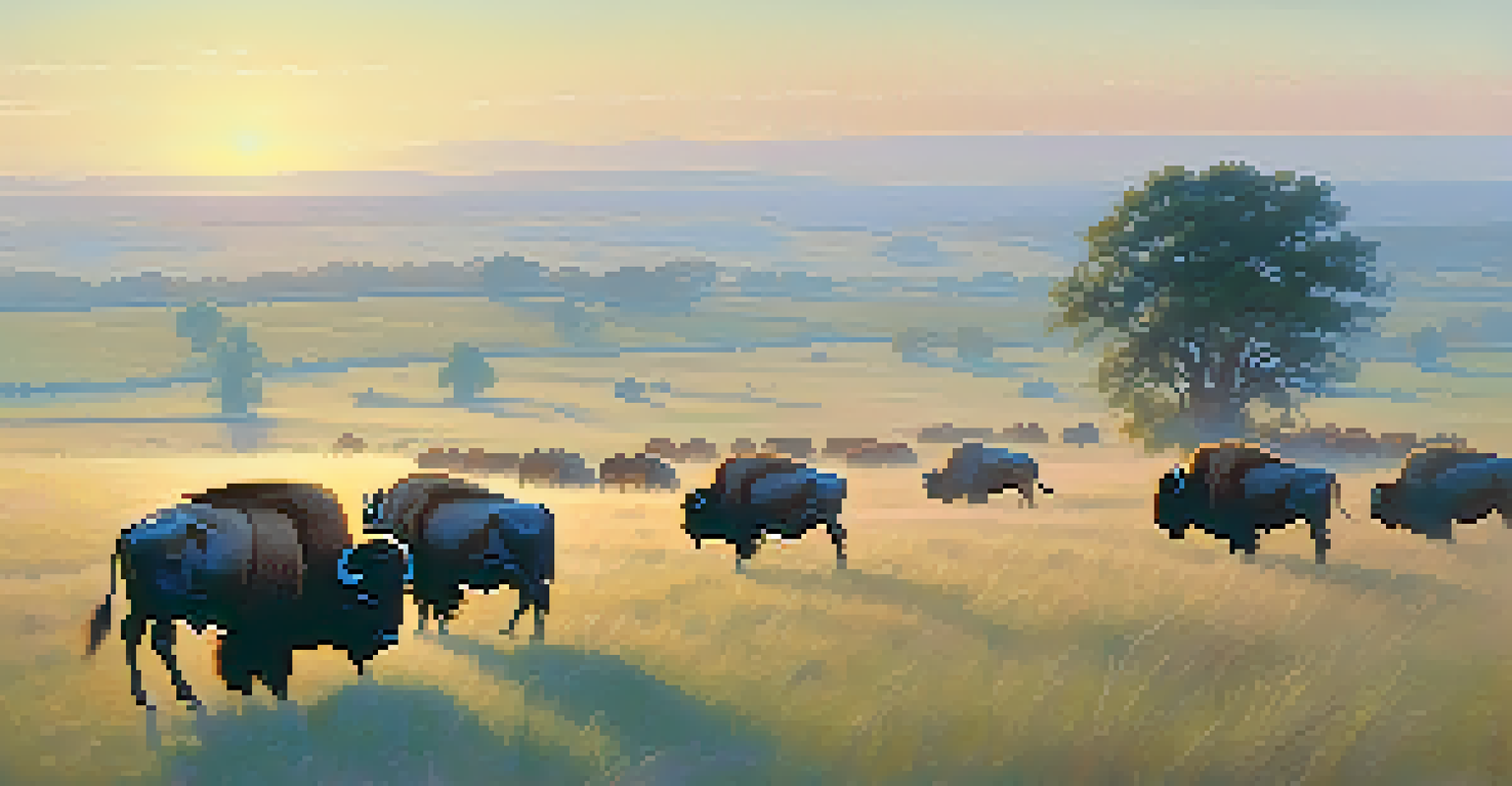The Influence of Buffalo on American Poetry and Prose

The Buffalo: A Symbol of Strength and Resilience
The buffalo has long been a powerful symbol in American culture, representing strength and resilience. For Native American tribes, the buffalo was not just an animal; it was central to their way of life, embodying survival and sustenance. This deep connection to the buffalo is often reflected in the poetry and prose of writers who draw inspiration from its significance.
The buffalo is a symbol of strength and resilience, representing the enduring spirit of those who came before us.
In works by poets like N. Scott Momaday, the buffalo emerges as a metaphor for endurance amidst adversity. Momaday's evocative imagery captures the spirit of the buffalo, illustrating how it serves as a reminder of the past while also inspiring hope for the future. Such representations help to solidify the buffalo's role as a central figure in the broader narrative of American identity.
This symbolism extends beyond Native American literature, influencing many American writers who seek to explore themes of nature, survival, and the human condition. The buffalo's resilience resonates with readers, reminding them of the strength found in facing challenges head-on, much like the animal itself.
Buffalo in Native American Poetry
Native American poetry often weaves the buffalo into its narratives, highlighting the animal's integral role in various cultures. Poets such as Joy Harjo and Linda Hogan use the buffalo to explore themes of interconnectedness and spirituality, demonstrating how this animal embodies the relationship between humans and the natural world. Through their verses, readers gain insight into the reverence held for the buffalo and its significance in cultural traditions.

For many tribes, the buffalo symbolizes not only physical sustenance but also spiritual nourishment. In their poetry, the act of hunting or caring for the buffalo is depicted as a sacred ritual, steeped in tradition and respect. This perspective enriches the reader's understanding of the buffalo's role beyond mere survival; it becomes a conduit for deeper connections to heritage and identity.
Buffalo Symbolizes Strength
The buffalo represents resilience and strength, deeply rooted in Native American culture and echoed in American literature.
These poetic portrayals serve as a reminder of the ongoing struggles faced by Indigenous peoples while celebrating their resilience. The buffalo becomes a powerful emblem, uniting past experiences with present realities, and inviting readers to reflect on their own relationships with nature and community.
The Buffalo in American Literature: A Broader Perspective
The influence of the buffalo extends beyond Indigenous literature into the broader realm of American prose. Writers such as Willa Cather and John Steinbeck have also drawn inspiration from the buffalo, using it to explore themes of survival, community, and the harsh realities of life in the American West. Their works often depict the buffalo not just as a creature of the plains but as a symbol of the American spirit itself.
In the buffalo, we see not just a creature of the plains, but a powerful emblem of survival and interconnectedness.
Cather's 'My Ántonia' features the vast Nebraska plains, where the buffalo once roamed, serving as a backdrop for stories of resilience and hardship. This connection to the buffalo helps to evoke a sense of place and identity, illustrating how the animal's presence is intertwined with the landscape and the lives of those who inhabit it. Such literary choices reflect a deeper understanding of the buffalo's impact on the American psyche.
Moreover, the buffalo's legacy continues to inspire contemporary writers, who recognize its significance in discussions about conservation and the environment. By incorporating the buffalo into their narratives, these authors not only honor its historical importance but also advocate for a greater awareness of the natural world and our responsibilities within it.
Buffalo in Modern Poetry and Prose
In modern poetry and prose, the buffalo remains a potent symbol, reflecting contemporary issues such as environmentalism and identity. Writers today often use the buffalo to address themes of loss, regeneration, and the urgent need for a deeper connection with nature. This modern lens provides a fresh perspective, allowing readers to engage with the buffalo's story in new and relevant ways.
Contemporary poets like Gary Snyder and Sherman Alexie incorporate the buffalo into their works to highlight the ongoing struggles faced by Indigenous communities and the fight for environmental justice. Their writing often serves as a call to action, encouraging readers to reflect on their relationship with the land and the creatures that inhabit it. The buffalo thus becomes a rallying point for discussions about preservation and respect for nature.
Cultural Preservation Through Stories
Narratives about the buffalo play a vital role in preserving Indigenous cultures and educating future generations about their heritage.
This evolution of the buffalo's representation in literature underscores its enduring significance as a symbol of resilience. By bridging the gap between past and present, modern writers continue to honor the buffalo's legacy while inspiring a new generation to appreciate its role in American culture.
Buffalo: A Literary Motif Across Genres
The buffalo appears across various literary genres, from poetry to fiction and even non-fiction. This versatility highlights its importance as a motif that resonates with diverse audiences. Whether through a fictional narrative or a reflective essay, the buffalo serves as a powerful touchstone for exploring complex themes of identity, survival, and connection to the land.
In fiction, the buffalo often embodies the spirit of the American West, evoking imagery of vast landscapes and untamed wilderness. Authors like Larry McMurtry and Annie Proulx often reference the buffalo to evoke a sense of place and history, grounding their characters' experiences in the rich tapestry of American life. The animal thus becomes a character in its own right, shaping the stories told and the lives lived.
The buffalo's presence in non-fiction works, particularly those that focus on ecology or Indigenous history, further emphasizes its multifaceted role in American literature. These writings often seek to educate readers about the buffalo's ecological significance and the cultural narratives that surround it, fostering a greater appreciation for this iconic creature.
Cultural Preservation through Buffalo Narratives
The stories and poems centered around the buffalo play a crucial role in cultural preservation, especially for Indigenous communities. By telling the buffalo's story, these writers help to keep alive the traditions, history, and values of their cultures. This preservation is vital not only for maintaining a sense of identity but also for educating future generations about the importance of the buffalo in their heritage.
In many Indigenous cultures, oral traditions have long been the primary means of storytelling. The buffalo features prominently in these narratives, often serving as a focal point for lessons about respect, sustainability, and community. By transforming these oral traditions into written works, contemporary authors ensure that the wisdom passed down through generations continues to resonate with readers today.
Buffalo's Evolving Literary Role
As environmental issues gain prominence, the buffalo's symbolism in literature is evolving to address contemporary challenges and themes.
Through their literary efforts, these writers not only preserve their culture but also invite others to engage with and appreciate the richness of Indigenous stories. The buffalo thus becomes a bridge between cultures, fostering understanding and respect for the diverse narratives that shape the American literary landscape.
The Future of Buffalo in American Literature
As we look to the future, the buffalo will undoubtedly continue to inspire American writers across genres. Its symbolism of resilience and strength remains relevant in an ever-changing world, serving as a reminder of the importance of connection to nature and community. Emerging voices in literature are likely to explore new dimensions of the buffalo's legacy, incorporating contemporary themes and challenges.
With growing awareness of environmental issues, the buffalo's representation is bound to evolve. Writers may increasingly use the buffalo to address topics such as climate change, habitat loss, and the impact of human activity on ecosystems. This shift will not only reflect the current state of the world but will also reaffirm the buffalo's role as a symbol of endurance amid adversity.

Ultimately, the enduring legacy of the buffalo in American poetry and prose speaks to its power as a cultural touchstone. As writers continue to draw upon its rich symbolism, readers will be reminded of the buffalo's significance, ensuring that its story remains a vital part of the American literary narrative.